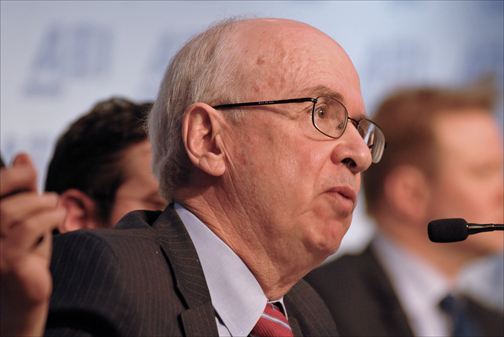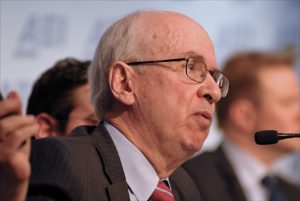AEI panel debates P.R. fiscal crisis in Washington


AEI’s Desmond Lachman discussed lessons from the Greek debt crisis that can be applied to Puerto Rico.
WASHINGTON — A group of economists meeting in Washington debated Puerto Rico’s fiscal future Wednesday, the day after a deadline for the Commonwealth to negotiate a payment plan with its debtholders expired, and just as Puerto Rico Gov. Ricardo Rosselló filed for a type of bankruptcy protection under PROMESA.
“Puerto Rico has three levels of crises,” lectured Alex Pollock, kicking off a two-hour panel at the conservative American Enterprise Institute. “One, it needs major reforms of fiscal management and controls. Two, reorganization of its massive debt and huge unfunded pension obligations, and last — and by far the most difficult — Puerto Rico needs to move from a failed dependency economy to a successful market economy, if we can figure out how to do that.”
The AEI’s keynote speaker was José Carrión, chairman of the seven-member Financial Oversight and Management Board for Puerto Rico.
Since its inception last August, said Carrión, the board has held seven public meetings — three in San Juan and four in New York — plus countless meetings with senior staff advisors, creditors and others involved in the crisis.
“One of the most difficult issues the board has had to tackle in advancing the PROMESA agenda has been determining as accurately as possible just what the government of Puero Rico’s revenues and expenses are. There are well over 100 different entities and 18 different issuers of debt,” he said. “Our findings confirm just how dire Puerto Rico’s financial situation is.”
Since 2003, the island’s population has declined by 9 percent, with 46.1 percent of the island’s 3.5 million residents now living below the federal poverty level, compared to a national average of 14.7 percent. Even worse, 63.7 percent of children under 5 in Puerto Rico are living in poverty, compared to a national average of 22 percent.
The island’s medium household income now stands at $18,626, compared to more than $56,000 on the U.S. mainland, and $27,862 in financially troubled Detroit. In October 2016, Puerto Rico’s unemployment rate was 12.1 percent, and only 987,606 people were employed — down 23 percent from the 1,277,559 who were gainfully employed in December 2006.
“Any real solution must involve all parties sharing in this effort,” he said. “It’s always tempting to avoid difficult choices by assuming the economy will grow faster. But in the past, this thinking always made problems worse. Puerto Ricans understand the problems that have held the economy back. For too long, the government has spent more than it’s collected.”
He added: “Welfare and labor laws protect those in need, but penalize those who choose to work. Investors cannot be blamed for giving up hope.”
Delaying reform will spur problems
Carrión said implementing reforms today doesn’t mean future ones won’t be necessary.
“PROMESA offers a rare opportunity for the government to restructure its debt in an orderly way,” he said. “If we delay much-needed reforms, we will face problems. That is why the fiscal plan certified by the oversight board imposes additional cost-cutting initiatives.”
These include a 100 percent reduction to municipalities, which will save $375 million a year; reductions in subsidies to higher education, which will save $475 million annually; a 30 percent drop in healthcare expenditures, saving $100 million a year, and an average 10 percent reduction in pension expenses, saving $250 million — not to mention cancellation of Christmas bonuses, four-day-per-month furloughs and other measures.
“After five years, the fiscal plan saves $3.6 billion a year, starting with $1.1 billion savings in its first year,” Carrión said, adding that the oversight board “shares the creditors’ desire” to enlarge the amount of money available to everyone.
“The fiscal plan starts by increasing revenues and cutting virtually all expenses in healthcare, education, even legislative expenses,” he said. “PROMESA was enacted to build a path to fiscal stability and restored access to capital markets. Without this legislation, the island would be facing financial and legal chaos. The people of Puerto Rico deserve better than that, but PROMESA’s objectives cannot be obtained without returning to positive economic growth. We are all in this together — and we must make now the difficult choices we have long known are necessary.”
After Carrión’s address and a Q&A, the panel — which including two members of the board and nationally renowned experts on Puerto Rico — discussed much-needed reforms for the island.
Harvard Kennedy School’s Antonio Weiss pointed out that while PROMESA is useful, Congress must use Medicaid reforms and the earned income tax credit to spark growth in Puerto Rico. The AEI’s Desmond Lachman discussed lessons from the Greek debt crisis that can be applied to Puerto Rico. And Anne Krueger of the Johns Hopkins School of Advanced International Studies urged the implementation of energy and labor market reforms — especially lowering the minimum wage for youth and introducing apprenticeship programs.
“The majority of the students at the University of Puerto Rico come from private schools and are not poor,” insisted Krueger, former chief economist at the World Bank and a former managing director at the International Monetary Fund. She blamed politicians in both Washington and San Juan for the current mess.
“The U.S. shot them [Puerto Rico] in the one foot and Puerto Rico shot themselves in the other,” Krueger quipped. “It was like they were waiting for each other to do something, and they weren’t used to dealing with it. And the United States can certainly do more by fully funding Medicare payments to the island.”












